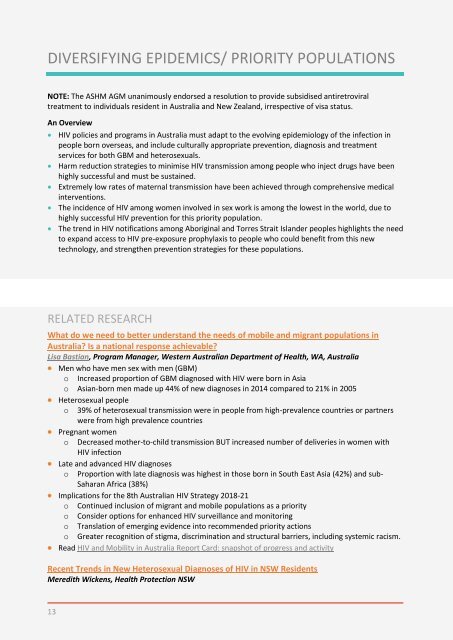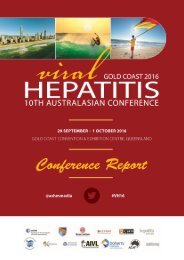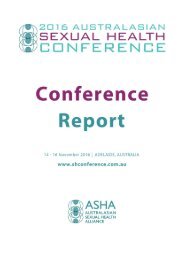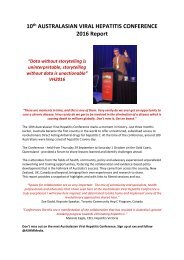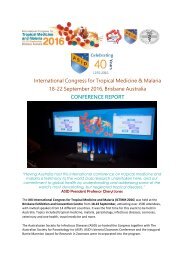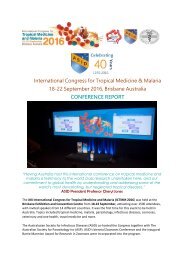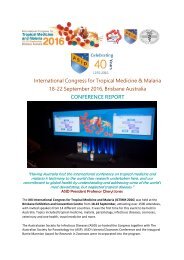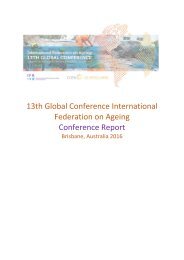AUSTRALASIAN HIV CONF REPORT 2016_FINAL
The Australasian HIV & AIDS Conference, run by ASHM, presents new and innovative research from across the Australasian HIV sector. Delegates include researchers, clinicians, policy makers, community organisations and activists. This 2016 Conference Report provides a collection of key learnings, with links to abstracts and presentations.
The Australasian HIV & AIDS Conference, run by ASHM, presents new and innovative research from across the Australasian HIV sector. Delegates include researchers, clinicians, policy makers, community organisations and activists. This 2016 Conference Report provides a collection of key learnings, with links to abstracts and presentations.
Create successful ePaper yourself
Turn your PDF publications into a flip-book with our unique Google optimized e-Paper software.
DIVERSIFYING EPIDEMICS/ PRIORITY POPULATIONS<br />
NOTE: The ASHM AGM unanimously endorsed a resolution to provide subsidised antiretroviral<br />
treatment to individuals resident in Australia and New Zealand, irrespective of visa status.<br />
An Overview<br />
<strong>HIV</strong> policies and programs in Australia must adapt to the evolving epidemiology of the infection in<br />
people born overseas, and include culturally appropriate prevention, diagnosis and treatment<br />
services for both GBM and heterosexuals.<br />
Harm reduction strategies to minimise <strong>HIV</strong> transmission among people who inject drugs have been<br />
highly successful and must be sustained.<br />
Extremely low rates of maternal transmission have been achieved through comprehensive medical<br />
interventions.<br />
The incidence of <strong>HIV</strong> among women involved in sex work is among the lowest in the world, due to<br />
highly successful <strong>HIV</strong> prevention for this priority population.<br />
The trend in <strong>HIV</strong> notifications among Aboriginal and Torres Strait Islander peoples highlights the need<br />
to expand access to <strong>HIV</strong> pre-exposure prophylaxis to people who could benefit from this new<br />
technology, and strengthen prevention strategies for these populations.<br />
RELATED RESEARCH<br />
What do we need to better understand the needs of mobile and migrant populations in<br />
Australia? Is a national response achievable?<br />
Lisa Bastian, Program Manager, Western Australian Department of Health, WA, Australia<br />
Men who have men sex with men (GBM)<br />
o Increased proportion of GBM diagnosed with <strong>HIV</strong> were born in Asia<br />
o Asian-born men made up 44% of new diagnoses in 2014 compared to 21% in 2005<br />
Heterosexual people<br />
o 39% of heterosexual transmission were in people from high-prevalence countries or partners<br />
were from high prevalence countries<br />
Pregnant women<br />
o Decreased mother-to-child transmission BUT increased number of deliveries in women with<br />
<strong>HIV</strong> infection<br />
Late and advanced <strong>HIV</strong> diagnoses<br />
o Proportion with late diagnosis was highest in those born in South East Asia (42%) and sub-<br />
Saharan Africa (38%)<br />
Implications for the 8th Australian <strong>HIV</strong> Strategy 2018-21<br />
o Continued inclusion of migrant and mobile populations as a priority<br />
o Consider options for enhanced <strong>HIV</strong> surveillance and monitoring<br />
o Translation of emerging evidence into recommended priority actions<br />
o Greater recognition of stigma, discrimination and structural barriers, including systemic racism.<br />
Read <strong>HIV</strong> and Mobility in Australia Report Card: snapshot of progress and activity<br />
Recent Trends in New Heterosexual Diagnoses of <strong>HIV</strong> in NSW Residents<br />
Meredith Wickens, Health Protection NSW<br />
13


